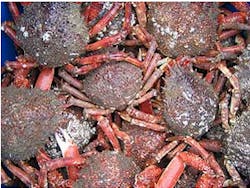Underwater sled helps fishermen image the sea
An underwater video camera system has been trialed by Seafish (Edinburgh, UK) to determine whether fishermen can monitor environmental conditions in marine protected areas (MPAs).
Seafish was founded in 1981 with the aim of supporting and improving the environmental sustainability, efficiency and cost-effectiveness of the fishing industry in the UK, as well as promoting sustainably-sourced seafood.
The trial used a towed camera sled specially designed and assembled by Dr. Andy Woolmer of Salacia Marine (Port Talbot, UK). The camera sled was fitted with an underwater video camera, a separate still camera and an underwater light and a laser scaling system to assess the size of objects recorded by the cameras.
The initial trial was carried out on the 38 ft Panther, skippered by Peter Nicholas, based at Burry Port in Wales. Seafish now aims to extend the trial and test the system on three commercial fishing vessels, based along the east, south and North West coasts of England.
"It is a legal requirement to monitor and report on the condition of MPAs. This is currently the responsibility of Natural England who would normally employ external marine consultants to do this. The alternative we are investigating here is to see how fishermen could be involved in the process. By extending the trial to three commercial vessels we will be able to see if the quality of the data collected could be used to report on the condition of MPAs," says Richard Caslake, Seafish Project Manager.
The project is being led by Seafish in collaboration with the National Fishermen's Federation Organization (NFFO), the South West Fishermen's Association (SWIFA), local fishermen's associations participating in the pilot, Natural England, the Marine Management Organization (MMO), CEFAS, the Inshore Fishery and Conservation Associations (IFCAs) and Defra. It is being funded by the European Fisheries Fund.
Interested in reading more about imaging technologies used at sea? Here's a compendium of five of the top stories on the subject that Vision Systems Design has published over the past year.
1. Marine robot captures images of wrecks
A marine robot designed and built by University of Limerick (UL; Limerick, Ireland) researchers was recently deployed to explore wrecks of The Aud and WW1 U-Boat, UC42 outside Cork Harbor.
2. 3-D sonar imaging system helps lay undersea cable
Engineers at Deep BV Hydrography and Geophysics (Amsterdam, The Netherlands) have deployed a 3-D phased array sonar system from CodaOctopus (Edinburgh, UK) to assist with the installation of a power cable at Thornton Bank.
3. Vision system celebrates six weeks underwater
An imaging particle analysis system from marine instrumentation manufacturer Fluid Imaging Technologies (Yarmouth , ME, USA) recently surpassed six weeks of continuous, unattended operation during in-situ deployment in the coastal waters of Florida.
4. Underwater Greek city mapped in 3-D
A team from the University of Sydney's (Sydney, Australia) Faculty of Engineering and Information Technologies has won top honors in Canon Australia's Extreme Imaging competition for their efforts in mapping and digitally reconstructing an ancient underwater city in Greece.
5. Camera captures polarized view of the ocean
A team of researchers at the University of Bristol (Bristol, UK) has developed a specialized camera that allows scientists to "see" polarized light, just as reef-dwelling animals do.
-- Dave Wilson, Senior Editor, Vision Systems Design
